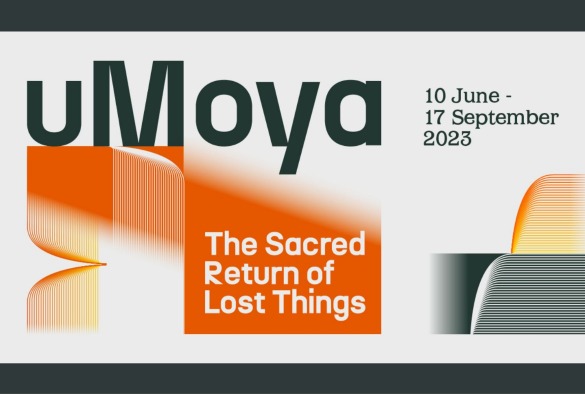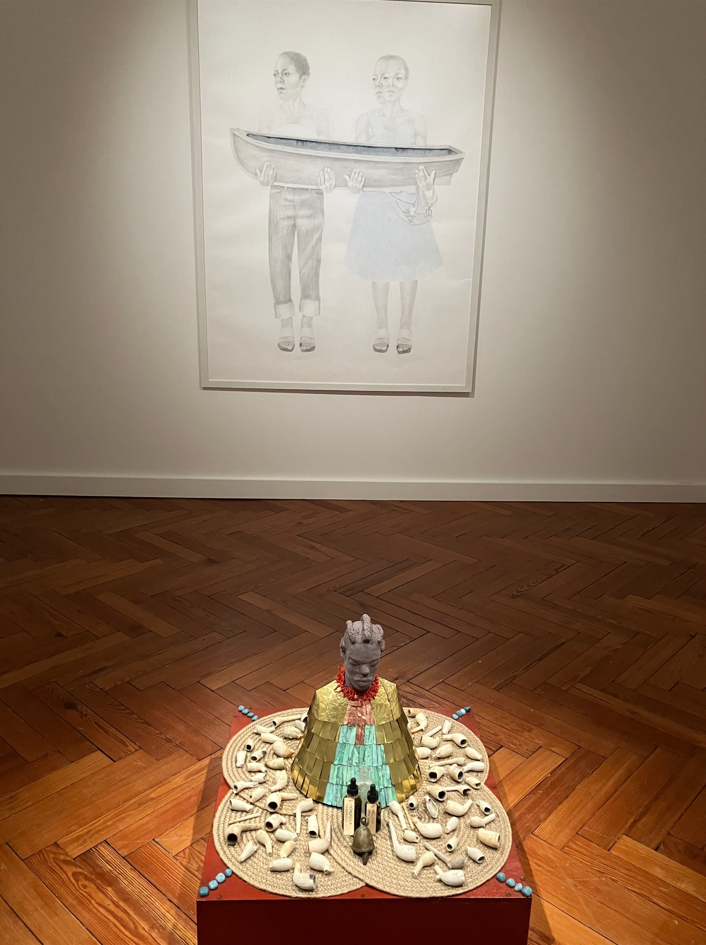
To celebrate three displays from internationally recognised artists at the Liverpool Biennial coming to our iconic Victoria Gallery and Museum, three of our lecturers in the Department of English have written responses to each of the displays. We’ll be posting a response every fortnight throughout the summer.
Our third and final response is from Dr Eleanor Lybeck, a Senior Lecturer in the Department of English and Institute of Irish Studies.
Her research and teaching centres on theatre and performance history and practice. Eleanor is a theatre maker herself and is currently adapting Virginia Woolf’s final novel ‘Between the Acts’; the adaptation explores hidden, contested, and contentious aspects of British history. The adaptation will be performed at the Liverpool Literary Festival on Saturday 7 October at 8.30pm.
Here, Eleanor reviews Charmaine Watkiss’ installation Witness:

When you walk into Charmaine Watkiss’s installation Witness, you walk into a room full of echoes. Together, the pieces that make up the work function as a four-way infinity mirror in which details and resonances are constantly traded back and forth. The overall effect of what Watkiss calls her ‘memory stories’ is subtle, quiet and uncanny.
A sign by the entrance instructs: ‘Please do not touch the objects.’ These objects, arranged around a deity elevated on a simple altar marked out by a length of ship’s rope, include a flint and semi-precious stones, a coral necklace, glass specimen bottles, and dozens of broken clay pipes, like bones, gathered as mudlark finds. Some of those pipes are marked with initials, others are pricked with elegant leaf patterns, and others still have hands drawn in an earthy pigment. On looking at those hands, it is difficult not to think of the hands that shaped the clay, that held and filled the pipe; the hands forced to harvest and cure the crop that filled them and the hand that recovered them at low tide. In front of the deity lies a bell we cannot touch but somehow hear, as visitors in the next room are encouraged to ring the many-hundred bells in Antonio Obá’s Jardim.
Tones and motifs emanate from this altar and project onto the triptych of large-scale pencil drawings hung upon the wall. The gold of the deity’s cape highlights a tiny bird atop a lighthouse on one side of the room, who is magnified on the opposite wall in duller tones on a beacon waiting to be lit, or lit again. The blue of the semi-precious stones colours the dresses of two of the four women who all share the same face. One, whose head is captured in motion as if somehow looking from past to not-quite future, wears a garment marked with runes and symbols that match in their geometry the sheer puffed sleeves of her near-exact counterpart in contemporary dress. On another wall, the Water Goddess wears a gown fashioned from a map of Liverpool, as if anticipating, or recollecting, the fate of so many in her community. The city’s docklands are recognisable, but again only just, as we encounter them rotated at an angle and understand that, here, maps are simply more or less legible patterns themselves. On the sand at her feet there is a conch shell, immediately recalling the Gala Porras-Kim pieces in the previous room but also iconic of the sounds we might hear echoing around this sacred space: the hands of the goddess about to clap, the drum and the horn left unplayed, the stories told in silence through these objects and images.
It is this brilliant indirectness that allows the viewer to enter into the sacred world that Watkiss has created and to recognise ourselves in the space between the thing that was, and the thing as we remember it.
Our second response is from Dr Sophie Oliver a Lecturer in the Department of English interested in feminist historiography. Her current exhibition, ‘Poets in Vogue’, on at the National Poetry Library in London until 10 September, uses creative methods, making and speculation to approach the literary past.

Installation view of Antonio Obá, Jardim, 2022, and Gala Porras-Kim, Future Spaces Replicate Earlier Spaces, 2023. Photo: Mark McNulty
A set of shells once used as wind instruments imply sounds we’ll never hear. A collection of ancient Mayan moulds suggest the existence of figurines now gone forever. In Gala Porras-Kim’s delicate drawings, these objects are arranged as they might be in a museum collection, laid out carefully in rows, ready to be classified. But her shells are elusive, because their function can never be recovered. And though the moulds document the distant past, they also point to what is lost to us.
History is made strange in these works, which don’t provide facts or certain knowledge. The assumption that a museum like the VG&M can offer an unobstructed view of the past is challenged by Porras-Kim. She has other ideas for looking backwards. Her drawings ask: what if, as well as going to history to know how things were, we imagine how they were? What if we sometimes allow wonder to override the urge to pin down the past? Is history open to change?
This isn’t about denying historical truths but about creating the conditions for other ways of relating to and conceiving of them. In the museum world, arguments in favour of the rematriation of objects benefit from new ways of thinking about the past. So can the case for removing public statues of colonial and racist figures. Rather than think of history as a fixed thing that happened and can’t be altered, we might see it as a more unstable story, which is always being told and retold in the present. In place of ownership and rigorous order, we could accept that some objects are beyond our control, whether lost like Porras-Kim’s figurines or the sounds of her shells, or just better-served by the perspectives and histories of other places and other people. In addition to the authority of objective knowledge about the past, we can embrace speculation and imagination.
These alternative historical moods and modes bring with them different attitudes, from humility and openness to loving attachment (Porras-Kim’s careful, lyrical drawings suggest this kind of relationship with objects). How a society thinks about history also says a lot about its values. Porras-Kim addresses the past not to find out for sure what the world was like once, but to be curious about how it might have been and might still be.
Our first response is from Dr Sam Solnick, a Senior Lecturer in the Department of English and co-director of the Literature and Science Hub. Sam is interested in the intersections of the arts with questions of environment, biology and technology.
To wander through Antonio Obá’s interactive installation Jardim (‘Garden’ in Portuguese), with its reed-like wires each sporting a brass bell, is to experience an odd disorientation of scale and identity. The exhibition text describes the piece as simulating ‘a hunting or hideout environment’, where the bells function as a kind of bait, calling out for us to ring them. To give in to that temptation is to give away the position of our hideout, like a mouse rustling through garden foliage. But it is ambiguous where viewers are supposed to be positioned in this hunter/hunted dynamic. Generally those who ring bells in gardens are more likely to be predators than prey. Most obviously, they might be house cats, whose owners tie bells around their necks to give fair warning to songbirds, hedgehogs and other species that populate suburban gardens in ever-lower numbers.
Gardens are, by definition, cultivated spaces. Those humans who spend much time in them, unlike those who live in or near the diminishing areas that might be described as ‘wild’, are unlikely to be either predator or prey. (Although one of the reasons that I don’t have a cat is that I have internalized the – possibly true – folk wisdom that if I were to die it would happily eat my eyeballs.) But there is, to me at least, another way of looking at Obá’s concrete and metal garden, one that gives a different sense of cultivation and consumption, hunter and hunted.
The poet Ocean Vuong says: ‘To be gorgeous, you must first be seen, but to be seen allows you to be hunted.’ Such visibility-as-vulnerability is the condition of possibility for life in the so-called ‘walled gardens’ that dominate our experience of the internet. ‘Walled garden’ is the name given to websites, not least social-media platforms, that control users’ access and experience in terms of the content and functions available to them. When we negotiate the walled gardens of social media we cultivate whatever ‘gorgeousness’ is on that platform. We make ourselves appealing (a word that, etymologically, means to call out for attention, like a bell). This might mean snapping beach-body selfies for Instagram, listing showy CVs on LinkedIn or, if you are a puerile academic in the humanities like me, retweeting mediocre poetry memes. This makes us hunters: seeking out likes, retweets, jobs, links, influence. It also makes us visible, and therefore huntable. Our data and synapses become prey for advertisers, scammers and conspiracy theories that use our mothers’ Facebook profiles as camouflage.
It’s striking that the alert function of tech platforms normally takes the form of a bell. The pings of these digital bells are supposed to tell you that there is something on your feed that you really need to see (there isn’t). In actual fact, the noise is a (semi-addictive) lure designed to capture our attention, to increase our screen-time and interactions. In the walled gardens of the attention economy – or what is sometimes called ‘surveillance capitalism’ – we are not consumers, but product; prey, not hunter.
If that’s the case, then maybe the question that Obá’s garden asks us to think about – in a world where digital and organic environments are becoming more controlled, coerced and diminished – is ‘where is there left to hide?’